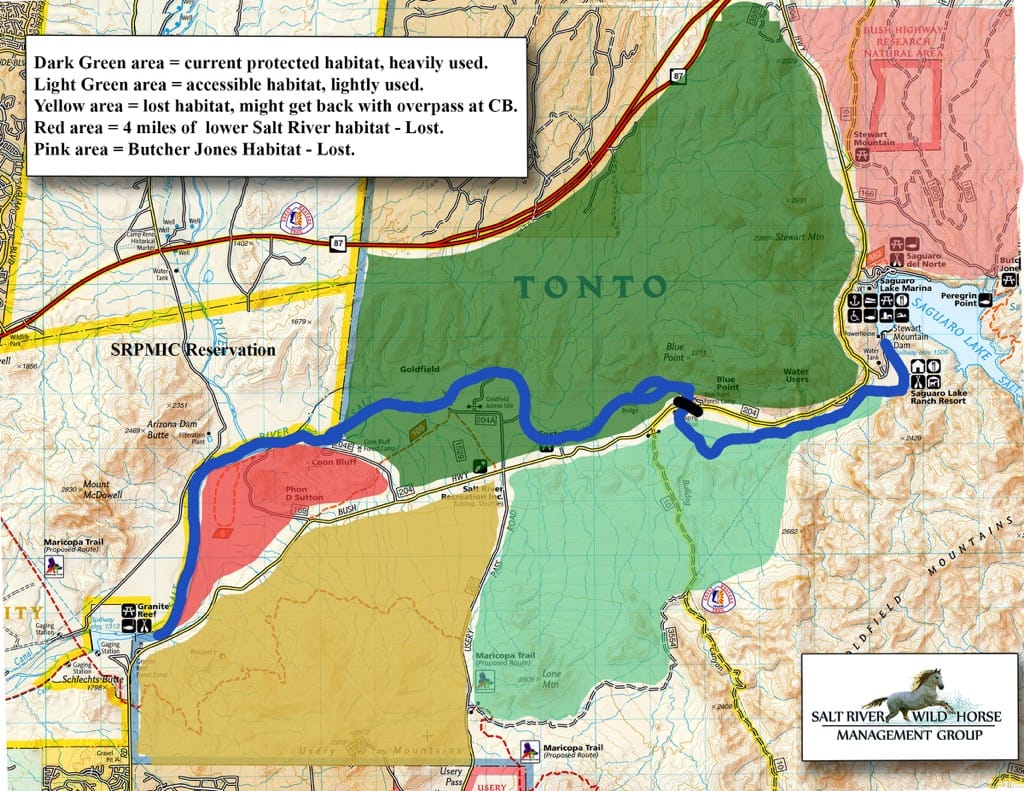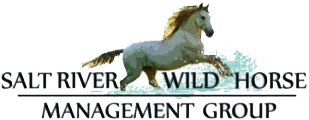
Salt River River Horse Habitat Explained
June 20th @ 8PM
Because we get a lot of questions, confusion and strange rumors on this, we’ve made this colored map to explain the best that we can. The Salt River wild horses live on Tonto National Forest exclusively, and this map represents the current situation.
First it is important to understand that we work with the authorities, but we do not make the rules and we cannot make decisions. While we often try to influence them in the horses’ favor, decisions are made only by the Tonto National Forest, the AZDA and the Governors office, and they all communicate together.
As you may know there were recommendations made for a long term management plan, by the collaborative process last year, some of which, we strongly opposed. The recommendations (and the arguments) were mostly about how many horses is the right amount of horses and where do they get to live. Nothing has been permanently decided about that yet.
A. The dark green area on the map is their main and most used habitat. They can use the entire area freely, and there are no fences stopping them from going anywhere, except along the boundary of that green area, which is Bush Hwy, the 87, and the reservations. This area contains grazing meadows, mesquite forests and 12 miles of riparian area. The SRWHMG rescue property is located in the upper right corner of this area on private property. The Forest Service compound and the MCSO station are on goldfield road. This area is called the Goldfield area, it includes the recreation sites of Coon Bluff, Goldfield, and Blue point and when you take the trails there, there’s a good chance you will see many wild horses. (please respect them)
B. The light green area connects to the dark green area through and under the Blue Point bridge only. (The bridge is in black) This area is currently part of their habitat, but is less frequently used. The most important part of it borders the river at Water Users, which it is a good spot for eelgrass. Some bands are having trouble passing under the bridge, since it is has been extremely busy there lately. Once they pass under the bridge, they also have access to the entire Bulldog area, which is used mostly during the winter as grazing grounds. This area is called the Bulldog Area. It includes the Rec areas of Pebble Beach and Water Users. You can see several bands there if you get lucky. (please respect them)
C. The yellow area is the south side of Bush Hwy that was heavily used and loved by the horses because of the good grazing meadows. It is not permanently lost, but they currently cannot access it, because they would have to cross Bush Hwy, which is not safe unless they get an overpass. An overpass would be expensive, but we believe it is important to the horses to get this overpass, because the grazing there represents almost 30% of the forage they need, and it gives them space to get away from the crowds. Horses would also greatly reduce the firedanger in that area. It is called the Usery area. It includes no rec areas, but has many people gates for entrance and rollover gates for bikes.
D. The small red area on the left is the area between Granite Reef and Coon Bluff, which is permanently lost habitat, because it no longer has access to the river. Because that area of the Salt River borders the Salt River Pima Maricopa Indian Community (SRPMIC), the Forest Service constructed pipe fencing along those 4 miles of river, on the Forest Service side, as a boundary fence. We opposed this fence, because that area was historic habitat important to the wild horses for 2 reasons, 1. It is the quietest part of the river where horses liked to spend their summers away from the crowds and 2. It is where all of the river eelgrass grows, which is an important part of their diet.
The effect this fence has had is that we ended up with more horses on the forest, who would have otherwise migrated back down to their hometerritories on the lower part of the river. It is why you might see more horses concentrated in the area of Coon Bluff. The few horses that you can still see below Coon Bluff are not part of the Salt River Herd, but part of the reservation herd.
The only good thing about this fence is that the Salt River herd can now be considered an enclosed herd, which is good for scientific reasons.
E. The pink area in the upper right corner is the Butcher Jones area. Farther north and off of this map, is where the Bush Fire is raging. Several bands lived there for several years, but it was not historic habitat, and because of problematic water access, plus the many conflicts with recreational use, the Butcher Jones horses were relocated to the dark green area, where we believe they are safer.
In conclusion: We hope this explains why you will see no horses at Butcher Jones, very few at Phon D and Granite Reef, just a few around the bridge, some in the area of Foxtail, and a ton of them between Coon Bluff and Goldfield.
This explanation is not to incite anger over lost habitat as we are way past that. It is simply an explanation of the 20.000 acres where they currently live and the 8000 acres that we hope to get back with an overpass. It is also to explain that no horses are lured away, no roundups are planned, and horses are not kept or moved anywhere. (with exception of the Butcher Jones relocation.)
We are thankful that to this date, no Salt River Wild Horses have ever been removed and we hope that it stays that way. We have asked for 5 years to prove that PZP works, and 10 years with the end goal a viable and sustainable herd size that everyone will be happy with.
We are thankful for the cooperation of the AZDA and the ability to manage these amazing creatures humanely. We are thankful for the efficacy of PZP, so that we can keep our promises to the Forest Service. We are thankful for the support of the governor and the tremendous support of the public.
We are proud of our accomplishments and the knowledgeable teams we have built. We are thankful for the hard work our volunteers are willing to do for these horses every day. We are grateful for the public who provide all of our resources, and we are looking forward to the day that we can finally say: “the Salt River wild horses are safe.”
Thank you for your support.
Sincerely, SRWHMG.
